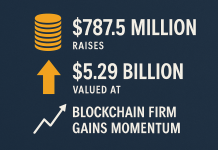[ad_1]
Crypto exchange Binance has been moving bitcoin funds to cold storage the past couple of days, and, of course, such large transfers don’t go unnoticed.
Two transactions destined for Binance’s cold wallet come to the fore and demonstrate both the power and irony of the blockchain. A transaction in block 550211 was a transfer of just over $1 million. For this transaction, Binance paid just over $8 in fees. The “high” amount of the fee is probably a matter of convenience, as the transaction was not particularly large at just 1550 bytes.
Binance just created the largest unspent transaction output existing today (but not all time) at 109k BTC (nearly $600M).https://t.co/Ot2ST37flU
— Antoine Le Calvez (@khannib) November 15, 2018
The other transaction, first flagged by Antoine Le Calvez of CoinMetrics.io, is more notable for its size — $600 million at the time it was sent, making it the largest unspent transaction output existing today — but also illustrates the irony of Bitcoin transactions, whose fees are not based on the amount transacted but instead the amount of computer resources required to store the information. This second transaction, made in block 550155 several hours earlier, comprised 5981 bytes yet cost the giant exchange just over $7.

Other factors, such as network activity, apply to transaction fee calculations.
Contrast With Traditional Transaction Movement
It should first be noted that there is no banking product with the same security as a cold storage wallet. A cold storage wallet is one that is not connected to the blockchain via the internet. With appropriate security hygiene, it can amount to having direct access to your personal fortune with no middlemen.
It would take days or weeks to find out the cost of moving funds between bank accounts from various banks, and banks are in particular not the best thing to compare Bitcoin with, it being primarily a remittance tool. Nonetheless, it is known that interbank fees generally run in the neighborhood of 4 percent or more, supposing the funds were being moved internationally. Domestically there would still be fees, which would depend very much on the bank being used.
Banks using Ripple‘s enterprise DLT products and other blockchain technologies might be able to reduce the cost significantly. Likewise, one-time deposits and other deals can be made with banks when moving this amount of funds. But this is cold storage, after all – funds that Binance will later probably need access to. The notion of paying any more than necessary fees for access or movement, and being reliant on external forces, is antithetical to the business of being a cryptocurrency exchange.
Which is to say, Binance is engaging in money transfers that wouldn’t have been possible in a previous era in order to facilitate a business model that wouldn’t have been possible in a previous era, all at a cost that would have been unimaginably low in a previous era.
We find it helpful to compare the cost of these transactions with a service like PayPal instead. While it’s unlikely that Binance would work with PayPal or that PayPal would work with transactions of this size, it’s useful to compare the value of Bitcoin to other remittance models. According to Salescalc.com, which specializes in such data, a fee of $17,400,000.30 would be incurred moving $600M to the PayPal account of the “cold storage steward” in the theoretical case of a PayPal model. PayPal does not charge fees for moving funds to bank accounts, but there is an associated delay when using traditional banking models.
Featured Image from Shutterstock
Follow us on Telegram or subscribe to our newsletter here.
Advertisement
http://platform.twitter.com/widgets.js
[ad_2]
Source link




